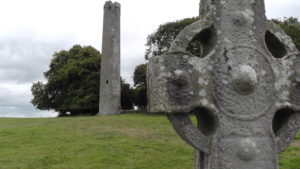While visiting Kilkenny recently we drove to the nearby 12th century Augustian Priory, one of the largest and impressive medieval monuments in Ireland.
Just outside the village of Kells, and about 15 km south of Kilkenny, the priory is situated alongside the King’s River.
We parked just off the road in a car parking area and had to climb over a stile and walk across a field to access the site. It was very peaceful with only one or two people looking around. We later discovered there were a couple of guides to show people around.
The priory was founded by Geoffrey Fitzrobert in 1193, brother-in-law to Strongbow (Richard de Clare, 2nd Earl of Pembroke). The priory succeeded an earlier church, dedicated to the Blessed Virgin and served as the Parish Church to nearby Kells village.. Geoffrey brought four canons over from Bodmin Priory in Cornwall to establish a community outside his borough of Kells.
In it’s early days, the priory was attacked and burned on three occasions, by Lord William de Bermingham in 1252, by the Scots army of Edward Bruce on Palm Sunday, 1326 and a second William de Bermingham in 1327.
In 1324, the Bishop of Ossory, an English Franciscan friar called Richard de Ledrede, paid a Lenten visit to the priory. There had been an inquisition into a Kilkenny sect of heretics, a Alice Kyteler and William Outlawe who had to appear before the Bishop on charges of witchcraft. William Outlawe was supported by Lord of Kells, Arnold de Paor who arrested the Bishop and had him imprisoned in Kilkenny Castle for 17 days. Lord Chief Justice, John Darcy investigated the events and the Bishop was vindicated. The Bishop again pursued Alice Kyteler. She was convicted in 1325 but escaped to England on the night she was due to be burned at the stake and was never heard of again. (She was the first recorded person condemned for witchcraft in Ireland).
The dissolution of Kells Priory took place in March 1540 when the property was surrendered to James Butler, 9th Earl of Ormonde.
The priory is divided into two parts, an inner monastic precinct along by the river and a larger, outer enclosure to the south. One of the most striking features is a collection of medieval tower houses spaced at intervals along the walls, enclosing a site of over 3 acres which gives the appearance more of a fortress than a place of worship. It’s local name is ‘Seven Castles.’
In more recent times, the place has been known as Burgher’s Court (the Burgess or Burgess Court) because it best reflects the purpose for which it was constructed and was thought to have been the site of the medieval borough of Kells. However, research now shows this was not the case. Today, all the monastic remains are grouped together in the ‘Precinct’ while Burgess Court is little more than a walled field with sheep and tourists.
In 1972, Tom Fanning, a state archaeologist began an excavation on the site. He died in 1993 but his work was completed by Miriam Clyne. The excavation was one of the largest ever undertaken in Ireland at a monastic house with the publication being the largest ever published on a rural medieval site.
20,000 archaeological finds, ranged from pieces of carved stone, Ham Green pottery (produced between 1100 AD to 1250 AD), fragments of wall paintings, floor and ridge tiles, metal objects and a collection of painted window glass which has allowed the reconstruction of what some of the window patterns may have looked like. The original priory church was a simple cruciform building, but later extended in almost every possible direction, including the fifteenth century second enclosure.
Micky and Leona were the names of the guides who filled in the history and took us up the tower which had a many, steep winding steps. It was worth the climb as you had a wonderful view from the top.
We were told that in the early 14th century the Fitzrobert line died out.
In 1893, Kells Priory became a National Monument in the guardianship of the Commissioners of Public Works. Ever since then, works of conservation have been undertaken at different intervals.
It is only this year that the Priory has opened to the public and will continue in this manner for the months of July and August only.
We travelled on a little further (4km S.E.of the Priory) to see the Kilree High Cross, believed to be of the 8th or 9th century and said to be the burial place of Niall Caille (High King of Ireland). The cross is made of sandstone standing 2.75m high. The East has a hunting scene on the arms. The ends of the South arm also have some figure sculpture. On the West face appears to be an Adoration of the Magi and Daniel in the Lions den. There is a tendon joint still visible which would indicate the cross was fitted with a capstone.
This site was used in the film Barry Lyndon (where an Irish rogue wins the heart of a rich widow and assumes her dead husband’s aristocratic position in 18th-century).
Before travelling on to our next destination, we stopped off at Mullins Mill (1 of 16 mills which once operated within a 5 mile stretch on the Kings River). This is a lovely tranquil spot with a small museum and craft centre where you can enjoy a coffee and cake while sitting outside overlooking an eye catching bridge. Originally constructed in 1725 with eight arches, it was widened and strengthened in 1775 and the new parallel structure had five arches. You can see both sets from the Mullins Mill side – the other side only showing the original eight arches.
We didn’t really have time to look around the museum, but did have a quick look at the crafts after finishing our hot, milky coffee.
Quite an exciting and interesting morning well spent!








